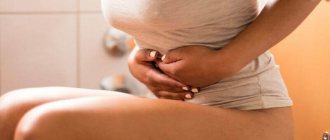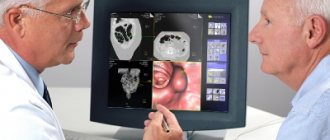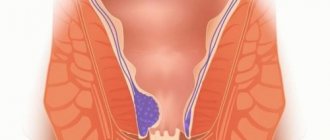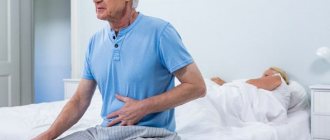Constipation is a very delicate problem. It is not customary to discuss it with friends and relatives. But according to statistics, about 15% of the world's inhabitants suffer from chronic defecation retention. Pathology not only causes discomfort, but also harms health.
Toxins present in feces penetrate into the blood and spread throughout the body. As a result, symptoms of intoxication appear. To avoid such complications, constipation should be treated without delay.
It is worth noting that chronic constipation is a functional disease. Diagnostics plays a special role in choosing the right treatment tactics, so it is often difficult to do without the help of a doctor, especially if we are talking about a serious defecation disorder.
In some cases, the causes of constipation are known to a person, and correction of the condition is not difficult; in others, treatment of the underlying pathology and special measures will be required. In the article we will look at the main causes of constipation and ways to get rid of the disease.
What is constipation
| Stool frequency | Less than three times a week |
| Consistency | Hard, dense |
| Bowel movement | Prolonged, with straining |
| Stool weight | Less than 40 g per day |
| Spastic constipation | Due to spasm of the intestinal muscles due to stress or illness |
| Atonic constipation | Due to decreased intestinal tone due to a sedentary lifestyle and poor diet |
Constipation is a disturbance in the bowel movement process. Constipation is diagnosed if a person goes to the toilet three times a week or less, or if he does so every day but has to forcefully strain.
Characteristics of signs
Symptoms of the pathological condition include the following signs of its development:
- Feeling of discomfort in the retroperitoneal space.
- Periodic, cramping pain.
- Abdominal distension.
- Suppressing the need to eat.
- Nausea.
- The feeling of need to empty the intestines is not supported by the actions of the body
The systematic accumulation of feces inside leads to reverse diffusion of decay products through the intestinal lining, which characterizes the development of intoxication of the body. The first sign of an imbalance of substances is a deterioration in the visual condition of the skin. When pores are clogged and a pustular rash appears, it is possible to positively diagnose a change in the metabolic process in the body, which is observed against the background of constipation.
Causes of constipation in adults
The causes of constipation include a number of medical conditions and social factors (lifestyle, stress, etc.). Temporary constipation in adults often occurs when the diet is disrupted, when traveling, when taking certain medications, and during periods of illness.
Among the causes of constipation, there are organic and functional.
Organic causes of constipation
These include various diseases of the stomach and intestines that disrupt normal bowel movements:
- congenital anatomical anomalies of the intestine;
- period after surgery on the intestines or stomach;
- inflammatory bowel diseases;
- intestinal obstruction;
- neoplasms (tumors of the intestine or surrounding organs).
Functional causes of constipation
They are not associated with diseases of the gastrointestinal tract.
- Emotional disorders (stress, depression, sleep disturbances, fears, conflicts, etc.).
- Violation of peristalsis, i.e. contractions of the intestinal muscles.
The reasons are drinking a small amount of fluid, poor diet, and lack of plant fiber in the diet. Fiber, i.e. plant fibers contained in vegetables, fruits, and cereals increase the volume of feces and help the intestines work properly. Another reason for impaired peristalsis is the lack of physical activity, which reduces the tone of the intestinal muscles and they slow down their contraction.
Lack of fiber in the diet can cause constipation. Photo: pixabay.com
- Taking certain medications can negatively affect intestinal motility and interfere with bowel movements.
These groups of drugs include antibiotics, non-steroidal anti-inflammatory drugs (Ibuprofen, Diclofenac), antispasmodics, antifungal drugs, etc.
Long-term use of laxatives can also have a negative effect, which contributes to the development of dysbiosis and decreased intestinal tone.
Constipation can lead to unpleasant consequences and significantly reduce the quality of life. Prolonged constipation is accompanied by abdominal pain, bloating, lack of appetite, gas formation, and nausea. Prolonged absence of bowel movements increases the risk of:
- dysbacteriosis;
- poisoning of the body with harmful substances (intoxication);
- hemorrhoids;
- disruption of internal organs;
- development of enterocolitis;
- development of polyps and other intestinal cancers.
Diagnostics
Adults with complaints of constipation are referred for examination to a gastroenterologist. The doctor collects anamnesis and provides a physical examination. The complex of mandatory diagnostic measures for defecation disorders includes modern instrumental methods for studying the gastrointestinal tract, clarifying laboratory methods. The most informative are:
- Irrigoscopy
. The double contrast method allows you to evaluate the anatomical and functional features of the large intestine, detects deformations of the intestinal contours, space-occupying formations and filling defects. For a detailed study of the digestive system, barium passage radiography is used. - Colonoscopy
. An endoscopic examination is designed to thoroughly examine the intestinal mucosa and detect diseases that manifest as constipation. During the study, a biopsy of the intestine is performed to clarify the causes of the disease. In the obtained biopsy samples, the cellular composition and the number of intramural nerve ganglia are assessed. - Sonography
. Ultrasound of the abdominal cavity is informative for the diagnosis of tumor neoplasms and adhesions. An ultrasound examination of the umbilical ring and the outer ring of the inguinal canal is recommended to exclude hernial protrusions or strangulation of intestinal loops. Women must undergo an ultrasound of the pelvic organs. - Coprogram
. The dry, hard consistency of feces, “sheep” or “pencil” feces, is determined macroscopically. Microscopic examination reveals an increased content of leukocytes and rotting products. An analysis of stool for helminth eggs, bacteriological culture, and the Gregersen reaction to detect occult blood are indicated. - Blood
tests . An advanced biochemical analysis is performed, measuring the concentration of glucose and electrolytes. It is necessary to establish the amount of free thyroxine and pituitary TSH. If glucose intolerance is impaired, an oral stress test is performed. To exclude chronic posthemorrhagic anemia, a clinical blood test is performed.
Symptoms of constipation in adults
In most European countries, the Thompson scale is used to make a diagnosis. The diagnosis is made if one or more symptoms from the specified list are observed on a regular basis for one year.
- Every third or fourth act of bowel movement occurs with obvious effort.
- The presence of hard stools every third or fourth bowel movement.
- The daily volume of feces does not exceed 35 g.
- The need to use aids for bowel movements.
- Fragmented, dry feces.
- The frequency of spontaneous bowel movements is less than 3 times a week.
Features of appearance depending on gender
The female body is more susceptible to constipation than the male body, which is due to the following reasons:
- Monitoring your body shape and cutting back on your diet.
- Periods of gestation.
- Poor nutrition during a shift work schedule.
- Reducing morning preparation time
Attention should be paid to the intervals in the life of the female body when the cause of constipation is pregnancy. During the growth and development of the embryo, the intestinal loops are compressed and move relative to the enlarging uterus. Against this background, a change in vascular nutrition is observed in the tissues of organs located in the pelvic area, contributing to the manifestation of frequent constipation.
The susceptibility to impulse contraction in muscle tissue decreases during this period, characterizing the state of atony of intestinal tissue. Regular constipation during this period is recommended to be controlled to avoid the appearance of straining due to excessive efforts to empty the bowel. For men, constipation is typical for almost the same reasons; by changing the quality of food consumed and choosing a passive lifestyle, you can get stagnation in the intestines, leading to the development of many pathological abnormalities in the functionality of the whole organism.
Treatment of constipation in adults
In the treatment of constipation, a proper and balanced diet, as well as the prescription of laxatives, play an important role.
Laxatives
Laxatives are divided into
- improving peristalsis (senna extract, Bisacodyl, etc.);
- increasing the amount of water in the intestines (various salts, lactulose, etc.);
- combining both properties (Regulax, etc.);
- enemas and microenemas that empty the large intestine.
However, most of the laxatives, when used for a long time, contribute to the development of side effects, such as dysbiosis, a feeling of a full intestine, dehydration, and addiction.
show more
What you can do at home
Medicines for the treatment of constipation in adults are prescribed exclusively by a doctor. The selection of medications depends on the cause of constipation. So, for example, if constipation is caused by a spasm, the prescription of the same drugs is required than in the case of intestinal obstruction. Therefore, self-prescription of laxatives is contraindicated.
Symptomatic therapy
If constipation is associated with age-related changes in the body, non-drug methods are primarily used to normalize stool. It is recommended to include fiber-rich foods in your diet: whole grain bread, fresh or stewed vegetables. To restore natural bowel movements, it is useful to drink about 2 liters of fluid per day. It is better to replace tea with fermented milk drinks and compotes. To stimulate peristalsis, older people need to eat a piece of bread with butter in the morning or drink 1 spoon of vegetable oil.
To strengthen the abdominal muscles and accelerate the movement of feces, it is recommended to perform a special set of physical exercises. To eliminate constipation, you can use herbal preparations - decoctions of buckthorn bark, yarrow herbs. To quickly cleanse the intestines, enemas are prescribed. For persistent constipation, oral laxatives and rectal suppositories are used. If stool is retained for more than 3 days, which is accompanied by intense pain in the abdominal cavity, a violation of the general condition, it is necessary to consult a doctor as soon as possible.
Diet for constipation in adults
Proper and balanced nutrition plays an important role in the treatment and prevention of constipation. It is necessary to know a number of foods that contribute to the development of constipation in adults. These include pureed dishes (mashed potatoes), dishes with a soft consistency, for example, semolina porridge, jelly, as well as strong tea, chocolate, and red wines.
Products that improve intestinal motility include:
- rye bread, bran;
- raw vegetables and fruits;
- buckwheat, oatmeal;
- lean meat;
- liquids (juices, mineral water, compotes);
- dairy products.
However, before prescribing this or that diet, you should consult your doctor. The use of plant fiber in large quantities can promote flatulence, cause intestinal spasms and pain.
Try not to overindulge in chocolate, as in large quantities it can cause constipation. Photo: pixabay.com
Anatomy of a process
The physiology of the structure of the intestine, as an organ of the digestive tract, includes several sections that provide the necessary range of functions:
- The small intestine includes the functionality of absorbing food prepared in the stomach.
- The beginning of the large intestine is represented by sections of the colon and has the ability to receive up to two liters of processed contents that have passed through the loops of the small intestine, and in the process of movement, ensuring the diffusion of fluid and minerals through the membranes of the department, while simultaneously forming feces.
- The sigmoid region is a reservoir of formed end products of the body's vital activity.
- The rectum is directly involved in the mechanism of pushing feces outside the body through the anal sphincter
Mechanism of motor activity
The process of transporting intestinal contents is ensured by spontaneous impulses occurring in the smooth muscle tissue of the walls of the organ, provoking contractile movements that push the masses along a fairly long path, which is on average from 5 to 6 meters. Muscular activity makes it possible to mix the contents more thoroughly, which ensures a more uniform thickening of the masses.
The internal contractility of the walls of the organ does not show any sensations for the body; only in the case of the development of a pathological abnormality do signs of concern develop. A person realizes the need to empty the intestines only when its contents reach the final section, as a result of which the rectum increases in diameter, irritating the internal nerve endings and forming an impulse, defined as the urge to defecate.
The direct mechanism of intestinal emptying has an equal relationship with both the voluntary course of the process and the one controlled by the person. The morning urge to defecate is normal, when the body changes its position, ensuring the movement of internal masses downward, irritating the receptors of the final section of the intestine. This phenomenon characterizes the optimal physiological rhythm of the digestive organs.
Preventing constipation in adults at home
- Balanced diet.
Introduce as many fresh vegetables and berries into your diet as possible. Don't forget about healthy fats in the form of vegetable oils, nuts, avocados, and sea fish. For breakfast, choose crumbly porridge with the addition of dried fruits.
Avoid fatty and fried foods. Eliminate quick snacks like sandwiches and fast food from your diet.
- Drinking regime.
Every day, for the proper functioning of the gastrointestinal tract and the maintenance of the body as a whole, a person must drink his individual norm of water. It is quite simple to calculate it. For every kilogram of body weight there should be 30 ml of clean drinking water. It is best to drink warm water regardless of the time of year.
- Physical activity.
A sedentary lifestyle is a direct path to intestinal problems. In order to maintain its proper functioning, weekly physical activity is necessary. Three training days a week will be enough. If for some reason you cannot afford to play sports, go to the gym or pool, start walking more, take the stairs without the help of an elevator, etc.
Preventive measures
Problems with stool in women can be prevented using prevention methods. Bulk laxatives can serve as a preventive measure - we remember that they can be taken for a long time. This is especially true for cases when, for various reasons, you have to limit yourself in consuming foods rich in fiber.
Other preventive measures include the following:
- morning exercises, a general increase in daily physical activity - walking, hiking, swimming, light fitness, yoga, stretching, dancing, etc.;
- formation of daily morning rituals - it is important, if possible, to adhere to the daily routine, get up with plenty of time to be able to go to the toilet without haste;
- correction of concomitant conditions, consulting a doctor about PMS, treatment of diseases of the pelvic organs, etc.
In some cases, it may be relevant to take probiotics and prebiotics to normalize the intestinal microflora, work with stress resistance and other methods aimed at eliminating the main causes of frequent constipation in a woman.
Popular questions and answers
Why is constipation dangerous?
Constipation is dangerous because it can lead to a number of other complications and diseases. The most common among them: ● exacerbation of hemorrhoids; ● anal fissures; ● irritable bowel syndrome; ● decreased absorption of vitamins and minerals from food and dietary supplements; ● irritability, depression or neurosis; ● chronic fatigue; ● formation of polyps; ● diverticular disease.
When to see a doctor for constipation?
You should make an appointment with a gastroenterologist if you visit the toilet 1-2 times a week and the situation does not change even if you change your diet or add physical activity to your schedule.
In addition, you should consult a doctor if you: ● have blood in your stool; ● pain in the anus; ● constipation alternates with diarrhea; ● no feeling of complete bowel movement; ● there is a need to constantly push to empty the intestines; ● there is a desire to empty the intestines, but it is not possible to do it; ● unexplained weight loss.
How effective are enemas for constipation?
Using an enema helps to get the desired effect within 5-15 minutes.
In addition, using an enema is one of the most popular and affordable ways to combat constipation at home. However, using an enema is not a treatment method and in some situations can only worsen the problem. ● Enema should not be used on an ongoing basis - this can lead to further complications (trauma to the mucous membrane, exacerbation of hemorrhoids). In addition, the use of enemas can cause addiction and the development of lazy bowel syndrome.
● Hemorrhoids and anal fissures are a direct contraindication to the use of an enema.
Sources
- Styazhkina S.N., Khairullin A.A., Gadelshina L.I., Merzlikina K.A. Hemorrhoids as a leading problem in proctology // StudNet. 2022. No. 4. https://cyberleninka.ru/article/n/gemorroy-kak-veduschaya-problema-proktologii
- Leonova M.V. Probiotics in the treatment of diseases of the gastrointestinal tract: effectiveness from the perspective of evidence-based medicine // Consilium Medicum. 2022. No. 8. https://cyberleninka.ru/article/n/probiotiki-v-lechenii-zabolevaniy-zheludochno-kishechnogo-trakta-effektivnost-s-pozitsii-dokazatelnoy-meditsiny
- Antonenko O. M. Treatment and prevention of constipation in pregnant women // MS. 2012. No. 7. https://cyberleninka.ru/article/n/lechenie-i-profilaktika-zaporov-u-beremennyh
- Petrov V.N., Zakharchuk A.G. Prevention and treatment of constipation in the elderly // Russian family doctor. 2008. No. 4. https://cyberleninka.ru/article/n/profilaktika-i-lechenie-zaporov-u-pozhilyh
Complications
The causes and consequences of constipation may be interrelated. For example, with proctogenic constipation, complications in the anorectal area develop faster: if defecation delay is associated with the appearance of hemorrhoids, then this condition will quickly lead to exacerbation of inflammation, thrombosis and other complications.
If stool retention does not occur as a result of anorectal pathologies, it quickly leads to them - it is one of the main causes of anal fissures, accompanied by bleeding, as well as complications associated with damage to the mucous membranes. These include cryptitis, paraproctitis, and pararectal abscesses that require urgent surgical intervention.
Complications from the digestive system such as:
- inflammatory diseases: colitis, proctitis, etc.;
- intestinal diverticulosis;
- stretching of the walls of individual sections of the colon, or megacolon.
One of the most serious complications of prolonged delay in bowel movement is acute intestinal obstruction. It requires urgent surgical intervention. Obstruction, in which there is no timely assistance, threatens to result in necrotic changes and death.
A delayed consequence of such constipation may be deterioration of chronic diseases. Chronic intoxication with waste products that the body cannot get rid of can become one of the causes of exacerbation of allergic diseases, deterioration of the body's resistance to infections, as well as exacerbation of dermatological diseases.
The accumulation of feces increases the risk of developing diseases of the genitourinary system, since surrounding organs are compressed. Thus, stool retention can aggravate the condition of diseases of the bladder or reproductive organs in women.
With chronic constipation, the risk of developing atherosclerosis significantly increases due to increased cholesterol levels. In addition, delayed bowel movements are a risk factor for colorectal cancer.
Is constipation dangerous? Yes, because it can cause tumor diseases. There are several mechanisms for the development of malignant neoplasms. One of them is the accumulation and stagnation of feces in the intestines, which leads to the release of carcinogenic compounds. Their long-term effect on the intestinal walls leads to tissue changes.
Regular bowel movements are one of the mechanisms for the disposal of “bad” cholesterol. In the absence of timely release of the digestive system, lipid metabolism changes, and the likelihood of the formation of atherosclerotic plaques in the lumens of blood vessels increases. This leads to a significant increase in the risk of cardiovascular diseases, heart attacks, and strokes.










